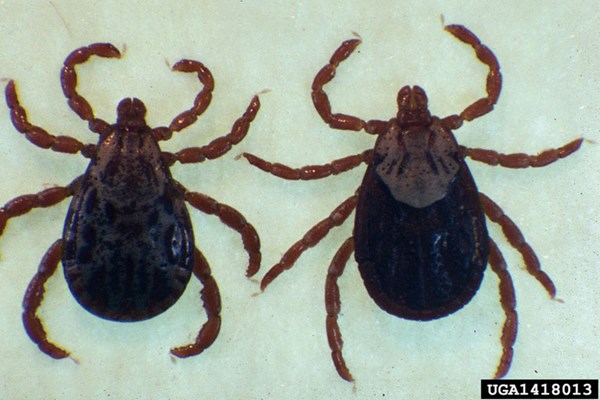
Ticks can transmit a number of disease‐causing organisms to horses. Two of the most common diseases which horse owners in Minnesota should be aware of are anaplasmosis and Lyme disease.
Anaplasmosis is the tick‐transmitted disease that most commonly causes illness in horses. The causative organism, Anaplasma phagocytophilum, is a bacterium that was previously called Ehrlichia equi, hence the persistent older disease name, equine ehrlichiosis. Ticks can also transmit this organism to humans and other animal species, including dogs and livestock, resulting in similar clinical illness.
Most commonly, the bacteria are transmitted from small mammals such as deer mice and wood rats via deer ticks, which may also be infected with the bacterium causing Lyme disease, Borrelia burgdorferi. In horses, clinical signs of anaplasmosis usually appear 10 to 45 days after infection. Fever is typically accompanied by limb swelling, and the appearance of small hemorrhages on the mucous membranes of the nose, mouth, eyes and/or vulva. Much less commonly, signs of incoordination, muscle inflammation or digestive tract pain may be observed.
Diagnosis is based on clinical signs in a horse with possible tick exposure during warm weather. The veterinarian attending the horse may confirm the diagnosis by drawing blood to assess the platelet count (cells responsible for clothing), which are usually low, and to look for the organism in white blood cells, particularly neutrophils. At the time the horse shows signs of illness, a raspberry‐like structure called a morula may be observed in some of these white blood cells of an infected horse. Blood can also be sent off to a lab for molecular tests for the organism or to look for antibody, but this is seldom necessary.
The disease can be fatal if not treated. Antibiotic treatment is usually very effective if the horse is treated soon after the signs of illness begin. The antibiotic of choice is oxytetracycline, which is administered intravenously at least once a day for 5 to 10 days. Oral doxycycline may be recommended either following initial oxytetracycline treatment, or in settings where daily veterinary visits are not feasible. Both antibiotics carry a slight risk of causing diarrhea. Relapses can occur if antibiotic treatment is too short. Other supportive care, such as nonsteroidal anti‐inflammatory drugs (NSAID, e.g., Banamine), and leg support wraps, are often employed.
Ticks found on the horse should be removed and destroyed. Other horses on the same farm should also be checked for both ticks and early signs of illness. There is no vaccine for this disease, so a horse owner’s best defense is to minimize tick habitat in their horse’s environment, use topical insecticides that include a label claim for ticks, and to remove any ticks found on the horse as promptly as possible.
Lyme disease, caused by the bacterium Borrelia burgdorferi, is much less frequently a source of illness in horses. Many horses are exposed to this organism through tick bites and very few develop clinical illness, usually months post tick bite. Research to experimentally recreate the disease in horses has so far failed to demonstrate significant clinical problems. As in dogs and people, the possible diagnosis of Lyme disease often arises when more common causes of lameness, joint swelling, kidney disease, moon blindness or incoordination have been ruled out.
Typically, two blood samples are taken 2 to 3 weeks apart to see if anti‐Borrelia antibody levels have changed significantly to indicate active infection. The two samples are important because many normal horses might carry high antibody levels. The disease can also be diagnosed by finding the organism in tissue taken by biopsy from an affected joint or lymph node. The SNAP test kits utilized for testing dogs for Lyme disease, likely are valid for use in the horse, but so far are not licensed for that purpose.
If evidence of Lyme disease is found, the veterinarian may try a course of the same antibiotics as for anaplasmosis, to see if this will improve the horse’s clinical abnormalities. There are currently no Lyme vaccines approved for use in the horse; however, the use of canine Lyme vaccine in horses in under investigation.
Horse owners need to be tick‐vigilant and manage their horses’ environment to reduce tick habitat. Clearing brush out of pastures and along both sides of fence lines is recommended. Keeping pastures mowed may also be helpful. Before riding through long grass or brush, the use of topical insecticides and staying on groomed trails is highly recommended.
For more information from the University of Minnesota Extension about horses visit their website.


